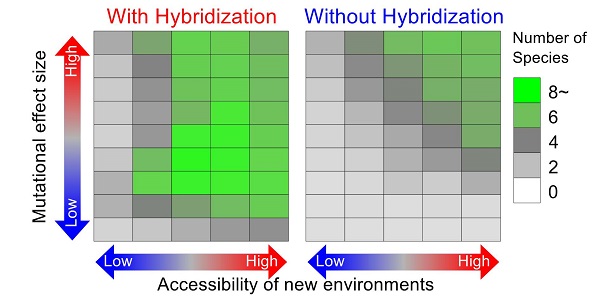Interspecies mating as promoter of evolutionary biodiversity Computer simulation clarifies hybridization's role in adaptive radiation


Summary of simulation results
The effect of hybridization on species multiplication is assessed by comparing simulations with and without hybridization under various conditions. The vertical axis shows phenotypic effect size of mutations and the horizontal axis shows accessibility to new environments. When accessibility to new environments is low, a specific novel phenotype is necessary for organisms to invade a new environment. The squares' color indicates the number of species that have evolved by the 10,000th generation under each simulation condition (averaged across 30 simulation runs).
© 2018 Kotaro Kagawa.
A study by researchers from the Swiss Federal Institute of Aquatic Science and Technology and the University of Tokyo used computer simulation to clarify that mating between animals of different species can trigger an explosive diversification of organisms.
Adaptive radiation, where ecologically diverse species evolve rapidly in a single taxonomic group, is found frequently in many regions on Earth, with hybridization gathering attention as a potential cause for driving this rapid evolution. For instance, scientists believe that mating between the hybrids of two parental species, which originally inhabited separate rivers, spawned the rapid diversification of tropical freshwater cichlid fishes in Africa's Lake Victoria region into more than 700 species. Researchers speculate that this ancestral hybridization increased genetic diversity, fueling the rapid evolution of ecologically diverse species. However, they were baffled by a couple ambiguities regarding the role of hybridization in adaptive radiation: First, since hybridization can cause not only the number of species to multiply, but also for existing taxonomic groups to merge and collapse, conditions favoring species multiplication remained unknown. Second, no study had assessed the importance of hybridization compared to other potential drivers of adaptive radiation, such as spontaneous mutations.
The present study, led by Dr. Kotaro Kagawa at the Swiss Federal Institute of Aquatic Science and Technology and Associate Professor Gaku Takimoto of the Graduate School of Agricultural and Life Sciences at the University of Tokyo, addressed these issues theoretically. The researchers investigated the role of hybridization in adaptive radiations by using virtual organisms on a computer, and simulating hybridization and evolution. They performed about 16,000 simulations, varying the environmental settings and evolutionary histories leading to hybridization. The simulation results suggested that hybridization can promote adaptive radiation most effectively when there are intermediate levels of genetic differentiation among hybridizing parental species. On the other hand, hybridization among species with low genetic differentiation remained mediocre, while high genetic differentiation tended to cause the hybrid population to collapse due to a drop in fitness. Additionally, simulations clarified that hybridization can be an essential cause of adaptive radiation when completely new traits are required for organisms to successfully invade new environments. These results suggest that hybridization could have played major roles in causing past adaptive radiations.
Nowadays, hybridization is induced by climate changes and human activities nearly everywhere on Earth. Thus, the present results provide a theoretical basis to predict the future of biodiversity in this changing world.
"Existing theoretical models cannot explain many aspects of a rise in adaptive radiations, but we believe a new evolutionary model incorporating hybridization may provide clues for solving this mystery," says Kagawa. He continues, "The evolutionary roles of hybridization are still largely unknown, and we wish to continue exploring this research field."
Paper
, "Hybridization can promote adaptive radiation by means of transgressive segregation", Ecology Letters Online Edition: 2017/12/14 (Japan time), doi: 10.1111/ele.12891.
Article link (Publication)
Links
Graduate School of Agricultural and Life Sciences
Department Fish Ecology and Evolution, Swiss Federal Institute of Aquatic Science and Technology






